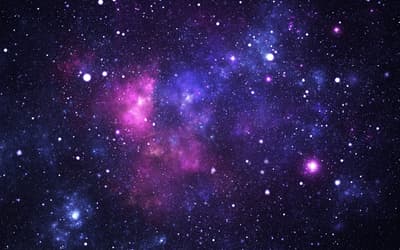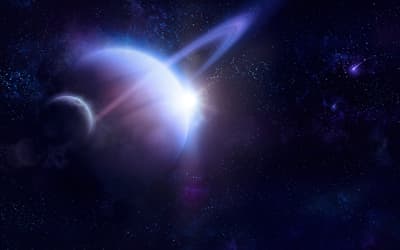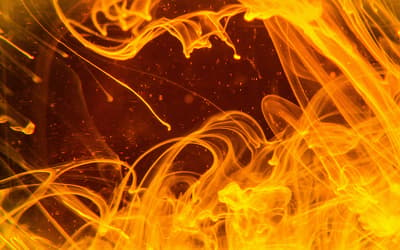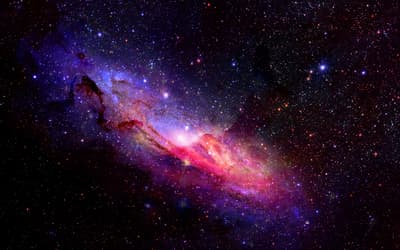The views expressed in this paper are those of the writer(s) and are not necessarily those of the ARJ Editor or Answers in Genesis.
Abstract
And God saw the light, that it was good: and God divided the light from the darkness (Genesis 1:4, KJV). In this modern era darkness has developed a new meaning. From various problems in cosmology a need has developed to postulate the existence of unknown types of energy and matter from the dark side. These are sought for in the dark sector of particle physics and in the description of the expanding universe acted upon by gravitation. Besides dark energy and dark matter, now a new dark component is being promoted—dark radiation—in the form of a sterile neutrino, which does not interact with electromagnetic radiation or matter except via gravitation. This has come about because of the dichotomy that has occurred when the total mass of the universe has been measured using two quite different methods. But this new development underlines the problems that have developed in cosmology, especially when the model (paradigm) being considered is a clear departure from the historical account in Genesis.
Keywords: sterile neutrino, dark radiation, mass of universe, big bang cosmology, dark sector
Is something dark going on in cosmology? If you thought dark energy and dark matter were hard to understand (and justify), now a new component has been added to the dark side—dark radiation.
When astrophysicists measure the total amount of matter in the universe using different methods, and different data sets, it has been found that they get quite different answers.
But before we proceed to look at this problem in detail we need to give this discussion some context. We should first understand that proposing the existence of some as-yet-unidentified particle is not bad physics per se. But we need to understand that dark matter, dark energy, and other “unknowns” (Hartnett 2008, 2013a) were only proposed in the standard big bang cosmology to resolve some conflicts between the standard paradigm and astrophysical observations. Therefore components from the dark sector (as it is called in particle physics) are essentially only needed when cosmology is involved.1 The Standard Model of particle physics alone, as contrasted with its application to cosmology, particularly big bang nucleosynthesis, does not really need them. The motivation is largely from cosmology and the worldview that the big bang is the correct cosmogony2 for the universe we see.
Besides the dark sector, including dark matter, dark energy, and now dark radiation, is proposed as an auxiliary hypothesis to rescue the standard big bang model from the inconsistencies in the observations (CMB, type Ia supernova data etc). This makes the paradigm particularly difficult to refute, because new physics (in the untestable cosmos) can always be added to resolve any conflicts.
However, Scripture tells us,
For the weapons of our warfare are not carnal, but mighty through God to the pulling down of strong holds;) Casting down imaginations, and every high thing that exalteth itself against the knowledge of God, and bringing into captivity every thought to the obedience of Christ; . . . (2 Corinthians 10:4, 5; KJV) (emphasis added)
The high thing in this case is big bang cosmology—it denies the Creator and it describes a sequence of events that are totally inconsistent with the Genesis 1 account (Hartnett 2014a). Nor does the timeline of 13.8 billion years since the big bang correspond in any way to the Creation account. If I may apply to this task what God told the prophet Jeremiah.
See, I have this day set thee over the nations and over the kingdoms, to root out, and to pull down, and to destroy, and to throw down, to build, and to plant. (Jeremiah 1:10, KJV) (emphasis added)
From the fraction of the verbs used, negative (pull down) compared to positive (build up) in this verse, I conclude that good biblical apologetics, means two-thirds of the time we should be destroying the works of the Devil, and one-third of the time building up the biblical model/truth. Therefore it is incumbent on us to highlight the problems with the atheistic cosmogony, which attempts to remove the Creator from His First Cause (Hartnett 2014b) role in the Universe. Anyway this is my line of reasoning.
The Mass of the Universe
Cosmologists have used the data from the latest Planck satellite survey of the Cosmic Microwave Background (CMB) radiation (Ade et al. 2013) to calculate cosmological parameters such as the total mass density, the baryonic (i.e. neutron and proton) mass density, the current epoch (i.e. the present time) Hubble constant (H0, for the expansion rate of the universe) etc.3 They have contrasted and compared them with those from the type Ia supernova (SNe Ia) data, using the Hubble Space Telescope (HST) (Riess et al. 2011)4 and other telescopes.
When applying the standard ΛCDM big bang model5 to the data, they found that these different methods resulted in different answers for the mass content and the expansion rate of the universe.
These discrepancies could be resolved if the missing mass was in the form of neutrinos or some other as-yet-undetected form of matter. Therefore the total amount of matter in the universe is a crucial cosmological parameter and it is very important for a correct interpretation of a great number of astrophysical phenomena.
The standard ΛCDM model applied to both CMB and SNe Ia data result in a universe with roughly two thirds dark energy and one quarter dark matter. Before the Planck observations were released, the calculation of the fractions of dark energy and dark matter, which included SNe Ia supernova data, were 72.8% and 22.7%, respectively. But after Planck these proportions were changed to 68.3% and 26.8%. The baryonic matter content (i.e. normal matter) was only slightly increased from 4.5% to 4.9%. Therefore the matter fraction of the total matter and energy content of the universe has shifted—and by a significant amount. In scientific terms the shifts were greater than the precision they had given to those percentages.
In fact, in the so-called age of precision cosmology, CMB data from the Planck satellite, from the WMAP satellite data release 9 (DR9) and the SNe Ia data from the HST (and other survey data sets including ground based telescopes) are in significant disagreement, or “tension” a term cosmologists use. See Table 1. The total matter content (= cold dark matter (CDM) + baryonic matter)6, are listed with 68% C.L.7 on errors, for these surveys, assuming a flat (Euclidean) universe.
The high precision of the determination of these parameters (the matter density and the Hubble constant) has led to a new problem. They do not agree and the disagreement is well outside even 68% C.L. on the uncertainty. The different methods result in significantly different answers.
In Table 1 the total matter density is in stark disagreement between that parameter determined with CMB data from the Planck satellite and when determined using the most precise HST SNe Ia data (SNLS). There is no overlap. See Fig. 1. That is what the errors indicate. This is one consequence of the so-called age of precision cosmology. Also the Planck data is in sharp disagreement with HST (2011) determined value for the Hubble constant (H0) and significantly so, with no overlap. The Union 2.1 data gives closer agreement for both parameters.
Table 1. Matter density and Hubble’s constant from different surveys
| Source | Survey | Total Matter Density | Cold Dark Matter | Baryonic Matter | H0 (km/s/Mpc) |
Ref. |
|---|---|---|---|---|---|---|
| CMB | Planck + WP (2013) | 0.315 ± 0.017 | 0.267 ± 0.007 | 0.0490 ± 0.0007 | 67.3 ± 1.2 | Ade et al. 2013 |
| CMB | WMAP9 | 0.279 ± 0.023 | 0.233 ± 0.023 | 0.0463 ± 0.0024 | 70.0 ± 2.2 | Bennett et al. 2013 |
| SNe Ia | HST (2011) | 73.8 ± 2.4 | Riess et al. 2011 | |||
| SNe Ia | SNLS | 0.263 ± 0.037 | Astier et al. 2006 | |||
| SNe Ia | Union 2.1 | 0.297 ± 0.020 | 70.4 ± 0.3 | Suzuki et al. 2012; Benitez-Herrera et al. 2013 |
WMAP9 = ninth data release from WMAP CMB project.
WP = WMAP Polarization (large scale EE polarization data from WMAP9).
SNLS = Supernova Legacy Survey.
Union 2.1 is from The Supernova Cosmology Project.

Fig. 1. Normal distributions of current epoch matter density of the universe (Ωm) determined from different astrophysical data sets. Relevant to this discussion are Union 2.1 (black dotted middle curve), Combined SNLS (blue solid left curve) and Planck CMB (green solid right curve) (after Melchiorri 2013, slide 36).
This has come about by application of the standard model to both CMB and SNe Ia data. With both of those data sets dark energy and dark matter are required for agreement between observations and theory.
Dark Radiation
It has now been suggested that the way forward to resolve this problem is to add to the dark sector—dark radiation—from a relativistic sterile neutrino (Archidiacono, Calabrese, and Melchiorri 2011) in the early big bang universe.8
The idea is this. In the early universe, consisting of a primeval plasma, neutrinos were in equilibrium, then, about 1s after the big bang, the universe had cooled sufficiently that the neutrinos decouple from the plasma (were set free) and form the Cosmic Neutrino Background, which has been theoretically estimated to have a temperature of about 1.945 K (today). (It has not yet been detected since neutrinos are notoriously difficult to detect.) Neutrinos were supposedly liberated from the plasma (mostly electrons and anti-electrons at that putative stage) and then they have travelled throughout the universe unimpeded ever since (Yanagisawa 2014).
In the standard model of particle physics there are three neutrino types, called flavors (electron, muon, and tau), and it is usually considered that at least one is massless. Once they were all thought to be massless, but the discovery of neutrino oscillations—whereby neutrinos change flavour and that requires their masses be different—implies at least two of them are massive. Particle-physics experiments such as SuperKamiokande in Japan, have determined that the sum of the neutrino masses is at least 0.06 eV, but the absolute values remain unknown.
They interact only by the weak nuclear force, which acts only over very short distances, and by gravity, which is extremely weak, hence the reason for them being extremely difficult to detect. As a result some have proposed that they might account for some of the missing matter in the universe, hence it has been hoped that they might comprise some of the sort-after dark matter. But based on big bang nucleosynthesis (BBN) calculations the number of neutrinos produced when neutral atoms first formed can be calculated relatively easily, and if the sum of the neutrino rest masses is 0.06 eV, neutrinos would make a negligible contribution to the total mass in the universe.
According to the theory, prior to the supposed period when the neutrinos were cooled and released from the plasma (decoupled), they were hot and relativistic. The standard model then predicts/assigns an effective number of flavours (Neff) for them in that plasma, where Neff = 3.046. The contributions to this number greater than 3 result from corrections due to non-instantaneous decoupling, finite temperature effects, and flavor oscillations. This has resulted, allegedly, from partial reheating of the neutrinos when electrons and their anti-particles, positrons, annihilated each other in the plasma. The number (Neff ) defines the correspondence between the energy density of the neutrinos and the photons in the plasma. Since there are only three known neutrino flavours, any significant additional contribution to Neff −3 > 0 would represent the presence of sterile neutrinos, or hidden sector photons, etc.; particles from the dark side.
Now here we have a problem. Planck and HST give very different values for the Hubble constant H0 (68% C.L.). See lines 1 and 3 in Table 1. But the Planck result is obtained under the assumption of Neff = 3.046. If you leave Neff as a free parameter (see next paragraph [Melchiorri 2013, slide 43]) you get H0 = 70.7 ± 3.2 km/s/Mpc, which is compatible with HST determined value. Note the errors now overlap.
But that means Neff > 3.046 and it means a new relativistic neutrino. Note first three lines of Table 2. When other data sets are combined with the Planck data you can see the resulting effect on the number of neutrino flavours needed in the universe. When radiation term at about 2.7 σ. This is clearly a result of the so-called tension between Planck and HST on the value of the Hubble constant when using the standard ΛCDM big bang cosmology.
Hence the dark radiation that is needed. Of course this means the CMB determination of the Hubble constant is model dependent. This therefore means cosmologists are free to explore the parameter space for new physics. This new physics involves what is called a sterile neutrino, because is does not interact with matter except via gravitation. That is, it does not interact by the weak nuclear force, as do the other known neutrinos, and hence it is called “sterile.” It is another dark component from the dark sector of physics, and it is needed to keep the big bang story alive. (It is important to understand this in light of the problem of cosmic variance [Hartnett 2014c].)
Table 2. Number of neutrinos when astrophysical data sets are combined.
| Combined survey data sets | Neff |
|---|---|
| Planck + WP + SNLS | 3.68 ± 0.77 |
| Planck + WP + Union2 | 3.56 ± 0.77 |
| Planck + WP + HST | 3.73 ± 0.54 |
| Helium abundance (Aver, Olive, and Skillman 2012) | 3.41 ± 0.30 |
| Deuterium abundance (Iocco et al. 2008) | 3.43 ± 0.34 |
| Deuterium abundance (Pettini and Cooke 2012) | 3.02 ± 0.27 |
Others (Archidiacono, Calabrese, and Melchiorri 2011) have calculated from the standard model and cosmological data Neff ~ 4.08 ± 0.71 at a 95% C.L. which strongly means a sterile neutrino species is needed. In the last 3 lines of Table 2 are listed the value determined by some other analyses of the physics of the BBN, which however find agreement with the standard model prediction of Neff = 3.046. These are in conflict to both Archidiacono, Calabrese, and Melchiorri (2011) and the latest results of the Planck satellite survey combined with other surveys (first three lines of Table 2), which favour some dark radiation.
Conclusion
Two different methods used to determine the mass of the universe and associated parameters, the Hubble constant for example, has led to the situation where it is required to propose the existence of a new dark entity, dark radiation in the form of a sterile neutrino, in order that the standard big bang model might be saved. This is based on the particle physics developed around what is believed to be relativistic hot big bang nucleosynthesis. So a new dark sector particle is required. But there was no big bang. This then means, that similarly to dark matter and dark energy, this is just another form of story-telling. An unknown is used to explain the unknown.
The big bang paradigm is the basis upon which this so-called precision cosmology advances, but it constructs an edifice of unknowns holding up unknowns. If this situation occurred in laboratory physics, in contrast to cosmology, the model would be discarded; it might even be called fraud. At the least it appears to me that mankind is building himself another tower of Babel, and a history of the universe without the Creator, because man rejects the One who made us and requires us to acknowledge and worship Him alone. All the glory to God.
References
Ade, P. A. R., et al. 2013. Planck 2013 results. XVI. Cosmological parameters. Retrieved from http://arxiv.org/pdf/1303.5076v3.pdf.
Aguilar, A., L. B. Auerbach, R. L. Burman, D. O. Caldwell, E. D. Church, A. K. Cochran, J. B. Donahue, et al., 2001. Evidence for neutrino oscillations from the observation of νe appearance in a νμ beam. Physical Review D 64:112007. Retrieved from https://journals.aps.org/prd/ abstract/10.1103/PhysRevD.64.112007.
Archidiacono, M., E. Calabrese, and A. Melchiorri. 2011. Case for dark radiation. Physical Review D 84, 123008. Retrieved from http://journals.aps.org/prd/abstract/10.1103/ PhysRevD.84.123008.
Astier, P., J. Guy, N. Regnault, R. Pain, E. Aubourg, D. Balam, S. Basa, et al. 2006. The Supernova Legacy Survey: measurement of ΩM, ΩΛ and w from the first year data set. Astronomy and Astrophysics 447, no. 1:31–48.
Aver, E., K. A. Olive, and E. D. Skillman. 2012 An MCMC determination of the primordial helium abundance. Journal of Cosmology and Astroparticle Physics 4. Retrieved from http://arxiv.org/abs/1112.3713.
Benitez-Herrera, S., E. E. O. Ishida, M. Maturi, W. Hillebrandt, M. Bartelmann, and F. Röpke. 2013. Cosmological parameter estimation from SN Ia data: a model-independent approach. Monthly Notices of the Royal Astronomical Society, 436, no. 1:854–858.
Bennett, C. L., D. Larson, J. L. Weiland, N. Jarosik, G. Hinshaw, N. Odegard, K. M. Smith, et al. 2013. Nine-year Wilkinson Microwave Anisotropy Probe (WMAP) observations: Final maps and results. The Astrophysical Journal Supplement Series 208, no. 2. Retrieved from http://iopscience.iop.org/0067-0049/208/2/20/.
Hartnett, J. G. 2008. Cosmology is not even astrophysics. Retrieved from http://creation.com/cosmology-is-not-even-astrophysics.
Hartnett, J. G. 2011a. Does observational evidence indicate the universe is expanding?—part 1: the case for time dilation. Journal of Creation 25, no. 3:109–114.
Hartnett, J. G. 2011b. Does observational evidence indicate the universe is expanding?—part 2: the case against expansion. Journal of Creation 25, no. 3:115–120.
Hartnett, J. G. 2013a. Big bang fudge factors. Retrieved from http://johnhartnett.org/2013/12/24/big-bang-fudge-factors/.
Hartnett, J. G. 2013b. Universe: Expanding or static? Retrieved from http://johnhartnett.org/2013/12/31/ universe-expanding-or-static/.
Hartnett, J. G. 2014a. The big bang is not a reason to believe. Retrieved from http://johnhartnett.org/2014/05/20/the-big-bang-is-not-a-reason-to-believe/.
Hartnett, J. G. 2014b. The Big Bang theory vs the Big God theory. Retrieved from http://johnhartnett.org/2014/01/26/the-big-bang-theory-vs-the-big-god-theory/.
Hartnett, J. G. 2014c. The largest structure in the observable universe or cosmic variance? Retrieved from http://johnhartnett.org/2014/06/19/the-largest-structure-in-the-observable-universe-or-cosmic-variance/.
Iocco, F., G. Mangano, G. Miele, O. Pisanti, and P. D. Serpico. 2009. Primordial nucleosynthesis: From precision cosmology to fundamental physics. Physics Reports 472, no. 1–6:1–76.
Melchiorri, A. 2013. First cosmology results from Planck, slide 36. Retrieved from http://webtheory.sns.it/symmetries13/ws_pdf/MELCHIORRI.pdf.
Pettini, M. and R. Cooke. 2012. A new, precise measurement of the primordial abundance of deuterium. Monthly Notices of the Royal Astronomical Society 425, no. 4:2477–2486.
Riess. A. G., L. Macri, S. Casertano, H. Lampeiti, H. C. Ferguson, A. V. Filippenko, S. W. Jha, W. Li, and R. Chornock. 2011. A 3% solution: Determination of the Hubble constant with the Hubble Space Telescope and wide field camera 3. The Astrophysical Journal 730, no. 2:119–136.
Suzuki, N., D. Rubin, C. Lidman, G. Aldering, R. Amanullah, K. Barbary, L. F. Barrientos, et al. 2012. The Hubble Space Telescope cluster supernova survey. V. Improving the dark-energy constraints above z > 1 and building and early-type-hosted supernova sample. The Astrophysical Journal 746, no. 1: 85–108.
Yanagisawa, C. 2014, Looking for cosmic neutrino background, Frontiers in Physics. Retrieved from http://journal.frontiersin.org/Journal/10.3389/fphy.2014.00030/full.









